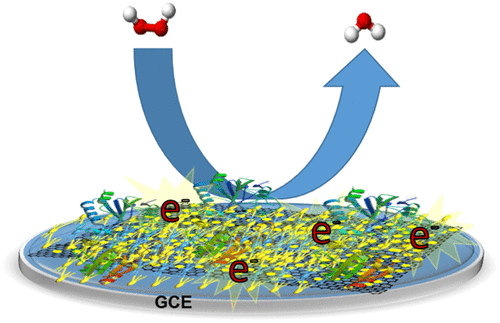当前位置:
X-MOL 学术
›
ACS Appl. Bio Mater.
›
论文详情
Our official English website, www.x-mol.net, welcomes your feedback! (Note: you will need to create a separate account there.)
Composite 2D Nanointerfaces for Electrochemical Biosensing: An Experimental and Theoretical Study
ACS Applied Bio Materials ( IF 4.7 ) Pub Date : 2020-11-23 , DOI: 10.1021/acsabm.0c01065 Renu Kumari 1 , Adeniyi Olugbenga Osikoya 1 , Francis Opoku 1 , William Wilson Anku 1 , Sudheesh Kumar Shukla 1 , Penny Poomani Govender 1
ACS Applied Bio Materials ( IF 4.7 ) Pub Date : 2020-11-23 , DOI: 10.1021/acsabm.0c01065 Renu Kumari 1 , Adeniyi Olugbenga Osikoya 1 , Francis Opoku 1 , William Wilson Anku 1 , Sudheesh Kumar Shukla 1 , Penny Poomani Govender 1
Affiliation

|
In this study, composite two-dimensional (2D) materials consisting of graphene (Gr) and tungsten disulfide (WS2) were coalesced with gold nanoparticles (AuNPs) through a self-assembly process to boost the conductivity of the resulting graphene–tungsten disulfide–gold nanoparticles (Gr–WS2–AuNPs) nanointerface structure. Structural and morphological characterization of the nanohybrid structure reveals crystalline thin flakelike agglomerates. Electrochemical characterization reveals an excellent electron transfer process for all the modified electrodes at the interface. The Gr/WS2/AuNPs/HRP/GCE modified bioelectrode exhibited a rapid electrobiocatalytic response in detecting H2O2 and a linear response from 0.40 to 23 mM, while 11.07 μA/mM/cm2 is the sensitivity value. This shows that the fabricated Gr/WS2/AuNPs/HRP interface structure is an excellent material for future developments in electrochemical biosensing and bioelectronics applications. The interactions, geometry, and energetic and electronic properties of H2O2 adsorption onto Gr/WS2/Au using the density functional theory (DFT) method have also been investigated along with the Grimme’s DFT-D3 dispersion method. Different adsorption modes of the H2O2 molecule onto the Gr/WS2/Au surface were considered. In almost all the cases, the adsorption was found to be energetically favorable and chemisorbed, with energies ranging from −2.198 to −3.782 eV. It was found that the W 5d, S 3p, and Au 6s orbitals play a vital role in the adsorption process. The H2O2 adsorption on Gr/WS2/Au remarkably decreases its work function, thereby increasing the field electron emission from the H2O2 molecule to Gr/WS2/Au.
中文翻译:

用于电化学生物传感的复合二维纳米界面:实验和理论研究
在这项研究中,由石墨烯 (Gr) 和二硫化钨 (WS 2 )组成的复合二维 (2D) 材料通过自组装过程与金纳米粒子 (AuNPs) 聚结,以提高所得石墨烯-二硫化钨的电导率-金纳米粒子(Gr-WS 2 -AuNPs)纳米界面结构。纳米混合结构的结构和形态表征揭示了结晶的薄片状团块。电化学表征揭示了界面处所有修饰电极的出色电子转移过程。Gr/WS 2 /AuNPs/HRP/GCE修饰的生物电极在检测H 2 O 2时表现出快速的电生物催化响应和从 0.40 到 23 mM 的线性响应,而 11.07 μA/mM/cm 2是灵敏度值。这表明制备的Gr/WS 2 /AuNPs/HRP界面结构是电化学生物传感和生物电子学应用未来发展的优良材料。使用密度泛函理论 (DFT) 方法与 Grimme 的 DFT-D3 分散方法一起研究了 H 2 O 2吸附到 Gr/WS 2 /Au 上的相互作用、几何形状以及能量和电子特性。H 2 O 2分子在Gr/WS 2上的不同吸附模式考虑了 /Au 表面。在几乎所有情况下,发现吸附在能量上是有利的并且是化学吸附的,能量范围从-2.198到-3.782 eV。发现 W 5d、S 3p 和 Au 6s 轨道在吸附过程中起着至关重要的作用。Gr/WS 2 /Au上的H 2 O 2吸附显着降低了其功函数,从而增加了从H 2 O 2分子到Gr/WS 2 /Au的场电子发射。
更新日期:2020-12-21
中文翻译:

用于电化学生物传感的复合二维纳米界面:实验和理论研究
在这项研究中,由石墨烯 (Gr) 和二硫化钨 (WS 2 )组成的复合二维 (2D) 材料通过自组装过程与金纳米粒子 (AuNPs) 聚结,以提高所得石墨烯-二硫化钨的电导率-金纳米粒子(Gr-WS 2 -AuNPs)纳米界面结构。纳米混合结构的结构和形态表征揭示了结晶的薄片状团块。电化学表征揭示了界面处所有修饰电极的出色电子转移过程。Gr/WS 2 /AuNPs/HRP/GCE修饰的生物电极在检测H 2 O 2时表现出快速的电生物催化响应和从 0.40 到 23 mM 的线性响应,而 11.07 μA/mM/cm 2是灵敏度值。这表明制备的Gr/WS 2 /AuNPs/HRP界面结构是电化学生物传感和生物电子学应用未来发展的优良材料。使用密度泛函理论 (DFT) 方法与 Grimme 的 DFT-D3 分散方法一起研究了 H 2 O 2吸附到 Gr/WS 2 /Au 上的相互作用、几何形状以及能量和电子特性。H 2 O 2分子在Gr/WS 2上的不同吸附模式考虑了 /Au 表面。在几乎所有情况下,发现吸附在能量上是有利的并且是化学吸附的,能量范围从-2.198到-3.782 eV。发现 W 5d、S 3p 和 Au 6s 轨道在吸附过程中起着至关重要的作用。Gr/WS 2 /Au上的H 2 O 2吸附显着降低了其功函数,从而增加了从H 2 O 2分子到Gr/WS 2 /Au的场电子发射。



























 京公网安备 11010802027423号
京公网安备 11010802027423号